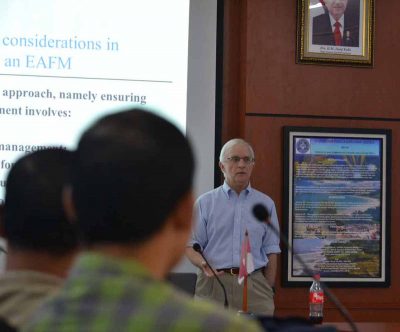
INTERVIEW WITH BOB POMEROY
The following interview appeared in the Jan. 28, 2019, edition of “Fish Forever Progress Update,” a newsletter published by the international organization Rare. It is reprinted with permission from the editors. The complete newsletter can be found here.
Dr. Bob Pomeroy is a fisheries extension specialist with the Connecticut Sea Grant Program, located at the University of Connecticut’s Avery Point campus in Groton. His areas of professional interest center on marine resource economics and policy—specifically, small-scale fisheries management and development, coastal zone management, aquaculture economics, international development, policy analysis, and seafood marketing. Dr. Pomeroy has worked on research and development projects in over 70 countries in Asia, Africa, the Caribbean, and Latin America and holds a doctorate in resource economics from Cornell University.
You recently co-authored an article with Rare, “Building household economic resilience to secure a future for near shore fishers in the Philippines,” based on a USAID Global Development Alliance project concluded in 2018. Tell us about this.
“I started working in the Philippines in 1983 and have worked on small-scale fisheries issues for the last 30 years in developing countries. I began to engage more closely with Rare as the idea of this project with USAID, “harnessing markets to secure the future for nearshore fisheries,” developed. I was particularly interested because I did, and still do, think it was an incredibly innovative project that brought new strategies and innovations to work — trying to link markets and livelihoods to sustainable fisheries and trying to develop incentive structures for people to engage more, with more ownership, over these strategies. In the Philippines and many small-scale fisheries around the world, the fisheries are extremely overfished, and there isn’t enough recognition that we need to begin to develop alternative, or supplemental, livelihoods to help the households so dependent on the resources begin to shift and become more resilient in other ways. And [it was important that] Rare began to recognize the need to focus on livelihoods.”
Why are you interested in the topic of resiliency and building household economic resilience for SSF?
“My PhD. is in resource economics, but you realize when you start to work in this field that one discipline is not enough to solve these issues. The key is that we need to broaden our perspective from just the fishery — and instead, focus on the household and ask ourselves, how do we make that household more resilient to all the drivers that are impacting upon it? A large part of that is expanding household livelihoods strategies to make them more resilient to these changes [climate change, increasing population, etc.]. A household receiving income from multiple sources will survive better than those just dependent on one source (fisheries). This GDA project training acknowledged that — it’s not just about conserving marine biodiversity, it’s ultimately enhancing and strengthening the household unit itself to be able to survive.”
Why is this topic important in the context of the literature, and what was your biggest takeaway from the GDA project?
“A lot has been written about the theory behind developing household resilience, but its practical application hasn’t been broadly undertaken. In 2017, we published an analysis of livelihoods projects and programs for fishing communities in the Philippines, reviewing what works and what doesn’t and defining success by those interventions maintained by the recipients one year after the project ended. The analysis shows that in the past, only about 15 to 20 percent of livelihood interventions have been maintained. So, the question then became, how can we make these interventions more successful and sustainable? In assessing 15 out of 100 identified projects, we came out with numerous recommendations for future projects — one of which was the need to engage with the communities to find out what their needs are before developing projects, so they have ownership from the start. The few projects that did that were most successful.”
Generally speaking, there are limited models for building household economic resilience for SSF. In this project, we tried to find niche markets that will pay a higher price for fish and link those back [to the communities] to provide an incentive to fish more sustainably. Given the lack of fish in the communities, we were not able to fully apply the model. We focused instead on learning how savings clubs and social franchising of conservation enterprises affected livelihoods. This project gave us a start to understanding and considering the different elements needed for success. Concerning a takeaway: I guess it’s that you CAN link economic incentives to sustainable fishing behavior. When you build in a financial reason to support something, you’re going to get the long-term sustainability to maintain it. If you’re going to move towards sustainable fisheries, people must have ownership over the process. So, when you’re poor, with few other options, being able to see and feel the economic returns occurring is critical to you. And, this project provides models that can do that.
What’s Next?
“Unfortunately, the fish supply to maintain any demand created through the project isn’t there in the Philippines. We are working toward rebuilding the fisheries. But, as far as I’m concerned, our strategy is still sound — and I think it will be very important, in places where Rare works with more fish, to begin to apply and replicate the project.”
Rare is an global leader in using behavior change to achieve long-lasting conservation results. To learn more about Rare, visit: https://www.rare.org.